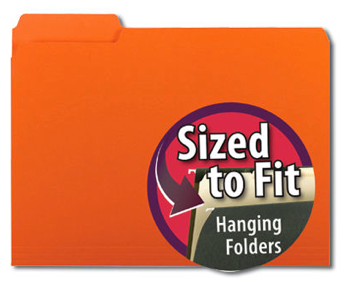
What kinds of filing supplies are right for you?
If you want to get as basic as can be, there's the manila file folder, the green hanging folder and the plastic tab. You'll find these supplies everywhere, and there's nothing at all wrong with them. But there are many more options to consider, depending on what your specific needs are — let's look at some of them.
File folders

Do you want file folders in fun patterns? There are many fine choices from companies like Galison, Blueink Studios, Cavallini and Co. — as well as the Metropolitan Museum of Art. This ostrich file folder comes from Paper Source.
Do you want to use color coding? Some people find this to be a royal pain; others love the idea. Even if you don't want color coding, would you prefer folders in a color other than manila?
Do you want file folders made from recycled materials? You can certainly get those, too. Pendaflex makes some file folders from recycled lottery tickets. [via organizer Julie Bestry]

And then there are the tabs. For files you'll use regularly, you may well want two-ply (or reinforced) tabs. If you like to have nice long labels on your files, you may want to consider file folders with straight-cut tabs, that run the entire width of the file folder.

And yet another option are file folders with a larger-than-normal tab. Smead calls these its SuperTab folders.
Hanging File Folders
Again, you can get files in various colors, and you can get files made from recycled materials.

If plastic tabs are too much of a hassle, you may want to get hanging files with the tab built in. Smead calls these its FasTab Hanging File Folders. For those who like straight-line filing, with the tabs in one position rather than staggered, you can buy these folders with a single tab position, rather than three.

But if you do use plastic tabs, I recommend the ones that are 1/3 cut (extending 1/3 of the length of the file folder) vs. those that are the shorter, more common 1/5 cut. I also recommend avoiding dark-colored plastic tabs, because these can make it hard to read the labels.
Combining file folders and hanging file folders
Do you want to have file folders inside hanging file folders? It's perfectly fine to use just one or another. David Allen recommends just using file folders, for the ease factor in setting up a new file — but many filing cabinets are set up to accommodate hanging files, not file folders.
If you do want to use both of them — with file folders inside hanging file folders — consider that many times the tab on the file folder will interfere with being able to read the tab on the hanging file folder. There are a number of ways around this, though; here are some ideas.

1. Put a number of files in a hanging box-bottom folder, and only label the file folders.
This is what I do with my client files. It's obvious they are client files; I don't need a label on my hanging box-bottom file folder to tell me that. The 2-inch size works well for many people, notes organizer Lorie Marrero.

2. Use interior file folders.
These are designed to fit inside hanging file folders with the tabs hidden.

3. Use the Find It tab view hanging file folders.
With these, the top of the hanging file is lowered so you can see the file folders inside. I haven't tried these yet, personally. Update on Feb. 2, 2015: Since I wrote this, I have had a change to try these out; they worked wonderfully for someone I know.
Related Post:
File Folders That (Almost) Make Filing Fun

No comments:
Post a Comment